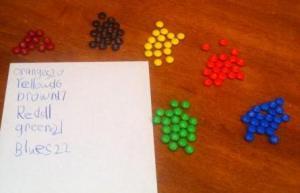Of course, if we had an index file we could look it up in the index file under “index file”. - Tegan Jovanka (Janet Fielding) in “Castrovalva”

When I was a wee lass, the blues were light brown.
Some of you may forget that before I was a whore I was a librarian, and the aptitude for both professions is rooted deep in my psyche. I talk about my whore-nature often enough, but today I want to talk about my librarian-nature, which is every bit as strong. Since I was a small child I had a passion for organizing things; my toys and games were returned neatly to their boxes after play, I was very regular in my habits, and I had little rituals about virtually everything I did. For example, at Halloween and Easter I would never gorge on candy, but instead budgeted myself one piece after every meal so I could make it last for weeks. This orderliness even extended to the eating process itself; for example, when eating M&Ms I would dump the bag out onto a table, make separate piles of each color and then eat one at a time out of each pile until they were all gone. And though I outgrew most of the petty rituals as I aged, I still have a passion for organization which infuses every important activity.
Observant readers will have noticed that I’m frightfully well-organized; I daresay few bloggers post exactly once a day, no more or less, at exactly the same time every day (with that time calculated so that all my subscribers are notified on the date of the post no matter where they are in the world). My columns mostly fall between 750-1500 words, and the exceptions prove the rule by being extremely predictable. Nearly everything about the blog, from the epigrams to the number and placement of pictures to the days on which certain types of column appear every week or every month, follows some rule (and even the deviations are governed by other rules). I already have some columns scheduled (though not written) well into March, and I chose the topic for this coming January 22nd almost a year in advance. No, I’m not that obsessive; I just like publishing columns about historical people or events on significant dates, and I happened to notice this one while researching something else.
Without all this order and organization, this blog would be impossible to use as a reference; it will reach 900 posts before the end of this month, so some logical structure is necessary to keep it from being nothing more than a chaotic mass of essays. I therefore thought y’all might appreciate a short tutorial on how to look things up in my indexing system. Back in April I published “Guided Tour”, which provided an overview of the blog’s layout, but today’s essay specifically concentrates on index features (and besides, a few things have changed since April).
Let’s start with the index pages, which are accessed via tabs at the top of the page. If you stop your cursor on the “Index” tab, you’ll see a drop-down menu of five subject indexes; clicking on the main tab instead will bring you to the title index, which is good if you already know the name of the column you’re looking for. In order to avoid long strings of similar titles, regular features like “That Was the Week That Was” and “Q & A” appear in sub-pages which can be reached by clicking on the feature’s name in the title index. If, on the other hand, you aren’t looking for a specific post but rather trying to see what I have written on a given topic, the subject index is what you’re looking for; each entry is a hyperlink, so if you look up, say, Buzz Aldrin (under “Aldrin, Buzz”) you’ll see that I mention him once, and can click on the name of that post to be taken directly to it in a new window.
The categories and tags which appear at the bottom of every column provide another handy means of cross-reference. If you’ve never explored these, take a moment to look at the end of this one; you’ll notice that categories and tags alike are clickable, and will take you to a reverse-chronological list of every column to date which shares the category or tag you clicked on. This isn’t really helpful if the topic is one that comes up often (e.g., “cops”, “dirty” and “ethics”), but is dynamite if you enjoyed a particular type of post (say, harlotography or fictional interlude) and want a list of all the other ones of that type.
 There is one more system of internal organization I’d like to discuss today, and that’s the reference links in TW3 columns. You’ve probably noticed that almost every item in those columns has a name referring back to an earlier column; well, that name is a link, and will take you back to the original column to which it refers. Let’s say you’ve just read a news item on sex robots; the title over the story would be “The Pygmalion Fallacy” (which was my very first column on the subject), and clicking the link would take you to it. If you really like that column, too, and you want to see everything I’ve written about sex robots, just scroll down to the tags at the bottom and you’ll see that there’s a “Pygmalion Fallacy” tag (alphabetized under “the” because computers are high-speed morons); because most items about sex robots appeared under that title, the link would show you most of them. If the title of the column does not appear as a tag at the bottom, it means that it has at most one update (a second one earns it a tag). And if you just can’t get enough robots, you could then look in the subject index under “robots” to find other columns in which they were mentioned.
There is one more system of internal organization I’d like to discuss today, and that’s the reference links in TW3 columns. You’ve probably noticed that almost every item in those columns has a name referring back to an earlier column; well, that name is a link, and will take you back to the original column to which it refers. Let’s say you’ve just read a news item on sex robots; the title over the story would be “The Pygmalion Fallacy” (which was my very first column on the subject), and clicking the link would take you to it. If you really like that column, too, and you want to see everything I’ve written about sex robots, just scroll down to the tags at the bottom and you’ll see that there’s a “Pygmalion Fallacy” tag (alphabetized under “the” because computers are high-speed morons); because most items about sex robots appeared under that title, the link would show you most of them. If the title of the column does not appear as a tag at the bottom, it means that it has at most one update (a second one earns it a tag). And if you just can’t get enough robots, you could then look in the subject index under “robots” to find other columns in which they were mentioned.
Well, those are the basics; the index grows with every post, and I’m currently involved in a long-term project to make the tags even more useful. If any of you have any questions about how something works, please ask it in the comments; I’d like this blog to be informative as well as entertaining, and the easier it is to find what you’re looking for, the more we accomplish that goal.
